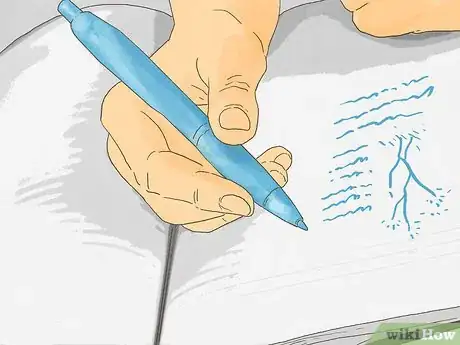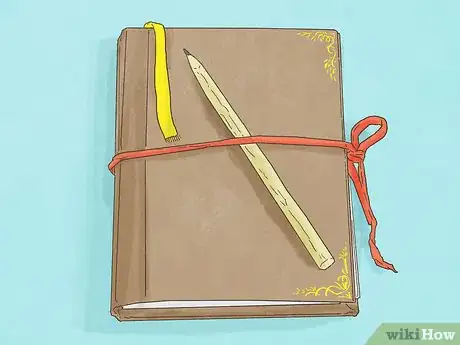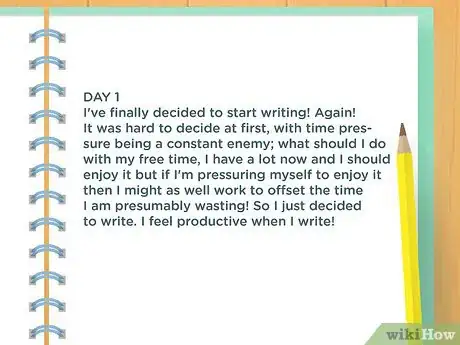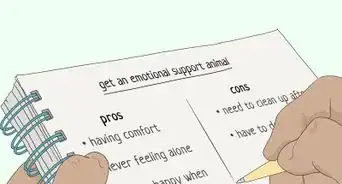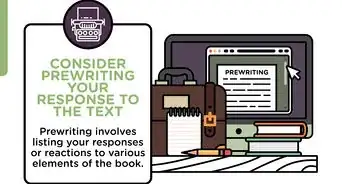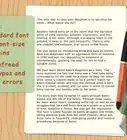This article was co-authored by Alexander Peterman, MA. Alexander Peterman is a Private Tutor in Florida. He received his MA in Education from the University of Florida in 2017.
This article has been viewed 43,032 times.
Whether you use a notebook for journaling, keeping a diary, sketching out short stories or poems, writing essays, or just scribbling down thoughts and observations during the day, it can be helpful to have a place specifically dedicated to writing. If you’d like to write more often than you currently do, having an appealing writer’s notebook can also help motivate you. If you enjoy the notebook itself, you’ll be inclined to crack it open and write, even on a daily basis. To start a writer’s notebook, find a notebook that you like and decide what type of content you want to fill the notebook with.
Steps
Finding or Making a Writer’s Notebook
-
1Decide what style and size of notebook you want. Notebooks come in a variety of sizes, from the small pocket-sized variety to large composition notebooks. Notebooks also come in both lined and unlined varieties—and lined notebooks can be found in both wide and college ruled. If you don’t want to use a paper notebook at all, you could opt to start a digital writer’s notebook by using documents or memos on your tablet, phone, or computer.
- If you’d like your notebook to be portable (in a shirt pocket or purse), a small notebook may be better. However, if you plan to be prolific and to fill every page with writing, a larger notebook may be more practical.
- If you’re notebook shopping on a budget, size will be the single factor that most determines the price—smaller notebooks, and notebooks with more flimsy covers are usually cheaper.
- If you plan to draw in your notebook, you may also want to find a notebook with graph-paper pages.
-
2Purchase a notebook. Visit a local office-supply store or bookstore, as these businesses will have the most variety in notebooks. Look through the selection, and find a notebook that appeals to you. It can be a spiral notebook, a composition notebook, or whatever kind you like.
- If you write a lot, and don’t want to constantly buy new notebooks, consider buying a three, four, or five subject notebook, so you have ample space to expand.
- Buying multiple notebooks will also be helpful if you want to categorize your writing into multiple subject categories.
Advertisement -
3Personalize your notebook. To make your notebook unique to you and your writing, you may want to divide the notebook up into different sections. For example, if you’re planning to write different genres, you could have poetry in the front, fiction in the middle, and your creative brainstorming in the back.[1] If you like, these sections can be marked with adhesive tabs to make them easier to find.
- You can also personalize the notebook by writing your name in the front, doodling pictures when you’re bored, or taping in a couple pictures of you and your friends.
- Your personalization doesn’t have to be messy or showy; it just needs to make the journal feel like it’s yours.
-
4Decorate the notebook with craft supplies. This step is optional, but if you have something decorated, it often makes you more likely to use it more frequently. Visit a craft-supply store and purchase glue, and pick up some colorful items that appeal to you.
- Get pictures, gems, feathers, strings, whatever you want to create your own personal writing place to escape.
- You can also decorate the cover of your writer’s notebook with stickers. You don’t have to do this all at once; build up a collection of stickers over time (through visiting local businesses, for example) and use them to make an appealing collage on your notebook’s cover.
Writing in Your Notebook
-
1Start writing something that you’ll enjoy. It’s important to have fun with your writing, especially when you’re just starting a notebook. Write some of your old story ideas, start a chapter of your novel, write dialogue, write down a funny conversation you heard at the store, etc.[2]
- Don’t worry whether or not your writing is “polished.” Just focus on writing something that’s interesting to you and that you can keep coming back to day after day.
-
2Remember to write in your notebook frequently. Although it’s exciting to start a new notebook, that excitement can quickly fade away. Set a schedule so that you remember to write—try writing every day, for example. If once a day is too often, plan to write two or three times during the week, or at least once a week. To get in the habit of writing frequently:
- Plan to sit down and write after you get home from school or work.
- Write first thing in the morning before you tackle responsibilities for the day.
- Write in bed at night, before you go to sleep.
- Find a time that works best for you when you are relaxed and undisturbed. This may vary on a day to day basis.
-
3Explore different genres and styles. Even if you already have a good idea of what you’d like to write, it’s still fun to try different types of writing. And who knows, maybe you’ll find a new style of writing that becomes your favorite. If you usually write fiction, try writing science fiction, fantasy, a detective story, or a comedic story.
- Give yourself some restrictions when you write to push you out of your comfort zone and try new things.
- Try writing poetry. In poems, you don’t need to have characters or plots; you can write about your feelings or observations of the world around you.
- Read a variety of works for ideas and inspiration. When deciding what to read, plan to focus on different genres so that you can see how well-known writers use descriptive language.
-
4Write multiple drafts of any project. No writer has a perfect first draft; it’s important to realize that writing is a process that often takes many drafts to perfect. Let your writing sit for a day or two, then return to it and re-read your own work. Figure out what the best parts of what you’ve written are, and then fix the parts that don’t seem to be as good.
- Always revise your work after you’ve finished a draft, a poem, or an essay. If you don’t like what you’ve written or you think it could be better, add or remove a section, change the genre or style, or change the point of view.[3]
-
5Get feedback on your writing. It can be tiring or feel pointless to write alone day after day; see if any of your friends or family members would like to read your work, and ask for their opinion. Although receiving helpful criticism can be tough, it will help you improve as a writer.
- You’ll also receive compliments on your writing, which are encouraging and can motivate you to continue writing or to try a new style of writing.
- However, if you would prefer your notebook and its contents to remain private—especially if you’ve written sensitive or personal information inside—that’s fine too. If someone asks to read your notebook, you can just say, “No thank you, I’d prefer that other people not read what I’m writing in my notebook.”
- Keep your notebook in a private spot in your room to prevent others from looking at it.
Generating Ideas for Your Writing
-
1Jot down notes, descriptions, or details. You can have an entire section of your writer’s notebook dedicated to quickly sketched notes. While these short impressions may not take up much room on the page at first, they will quickly accumulate as you find more things to describe day after day. These will make great details to use in a short story or essay.
- Write down the details right when you see them. It’s likely you’ll forget what you wanted to write the longer you wait.
- Note things like how a tree looks when it loses its leaves, how fresh baked foods smell, or how you feel at the end of a long day.
- Make notes of what you have seen in the past such as the author/artist and write any description of your inspiration in the start of the book.
-
2Listen to how people speak. Try listening in on someone’s conversation, write it down, and write your imaginary ending to the conversation.[4] This is a useful trick for learning to write dialogue in a story or novel—listen to the conversations of family, friends, and strangers around you, then imitate how they speak in your own writing.
- You can also try this by listening to someone’s conversation on the phone. You won’t be able to hear the other side of the conversation, but that is the fun part because you can imagine what the other person is saying and incorporate that into your writing.
-
3Plan out your story or novel. You can do this by making character pages, where you map out things about a character for a book or story that you are going to write. To practice, take notes on a real person, or make up a character resembling one in an existing book. If you’re writing fiction or a personal essay, draw on real-life experiences that you’ve had with your friends and family.[5]
-
4Have fun with words when you write. Words are one of the most fun parts of writing and can be explored through synonyms and antonyms, rhymes, and other word tricks. Try making word pages, where you look up descriptive words in the dictionary, and write the definitions down in your writer’s notebook.
- Try taking words you’ve already used in your writing and looking up their synonyms in a thesaurus.
- This will help you to use more descriptive words in your writing, making it more interesting and more detailed. It will also help you to expand your vocabulary.
-
5Describe scenes that you see. Use all five of your senses, and watch an elaborate sunset, stare at the mountains, sit in a field of waving grass—or do something simple like describing a cafe as you sit down and drink your hot chocolate or munch on a muffin. Drawing from real-life observation is a powerful tool that many professional writers use to enhance their own descriptions and imagery.[6]
- If you take your journal with you everywhere you go, you’ll be able to jot down impressions, observations, or phrases that you see or overhear throughout the day.
Community Q&A
-
QuestionWhat if I don't have any friends? What kind of pictures can I put in it?
 Community AnswerPut pictures of your pet, your family, your favorite things, celebrities, etc.
Community AnswerPut pictures of your pet, your family, your favorite things, celebrities, etc. -
QuestionCan I write a story about my life with a pet?
 NicoTop AnswererSure, if that’s what you want. Be sure to write about fun activities that you do with your pet (taking them to the park, e.g.), describe your pet’s personality, (loving, clever) and appearance (large, spotted) to give your readers a mental image. Include emotional moments, as well as happy times with your pet (taking them to the vet, for example).
NicoTop AnswererSure, if that’s what you want. Be sure to write about fun activities that you do with your pet (taking them to the park, e.g.), describe your pet’s personality, (loving, clever) and appearance (large, spotted) to give your readers a mental image. Include emotional moments, as well as happy times with your pet (taking them to the vet, for example).
References
- ↑ http://www.scholastic.com/teachers/top-teaching/2014/09/setting-writers-notebooks-part-2-inside
- ↑ https://letterpile.com/writing/Inspiration-Journal
- ↑ http://ralphfletcher.com/tips-young-readers/
- ↑ https://sarahbrennanblog.com/top-ten-writing-tips-for-kids/3-start-a-writers-notebook/
- ↑ http://ralphfletcher.com/tips-young-readers/
- ↑ http://ralphfletcher.com/tips-young-readers/


